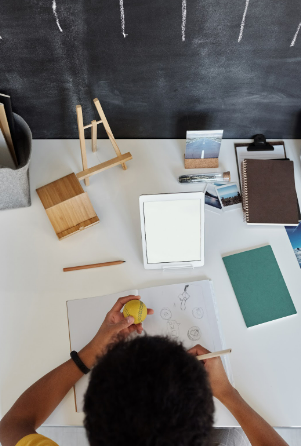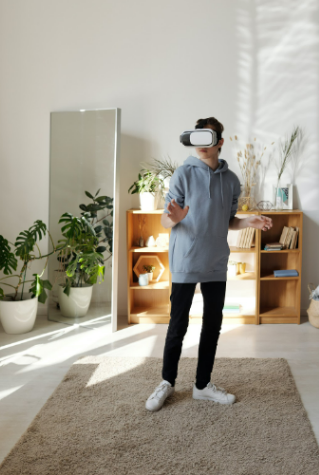Revolutionary new teaching methods have given more responsibility to students to direct themselves. This self-directed learning approach has led to huge improvements in learning goals by engaging students on a deeper, more enjoyable level.
Particularly with the COVID-19 pandemic, self-directed learning has emerged as a fantastic solution to the lack of engagement currently experienced with remote learning. Only 25% of students and teachers have found online teaching as effective as its classroom equivalent, and 1.6 billion children have been learning remotely in the past year. The disengagement problem is immense.
But with self-directed learning, and combining it with the help of virtual reality technology, students can learn quickly and effectively from anywhere, whether it’s at school or at home.
In this article, we’ll dive deeper into what self-directed learning is, what its advantages are, how VR can be used, and some of the benefits of virtual reality education. Read on to learn about these modern learning solutions for your students.
What Is Self-Directed Learning?
Also known as autodidacticism, self-directed learning broadly means a learning environment where the learner is in charge of their own lessons.
Rather than being guided by a teacher lecturing at a blackboard, self-directed learning allows students to take their education into their own hands. It gives them the freedom to explore and interact with open-ended problems, coming up with unique, creative solutions.
Instead of having right-or-wrong answers to strictly concrete questions, students are free to follow their intuition and experience to come up with answers. For example, in a chemistry lab, a student could be given several known compounds and asked to use them to identify an unknown compound with a few different instruments.
The student gets to work. With their instruments, they notice that they can measure mass and volume quite easily, and they also can perform a flame test. Of the known compounds, they note the density of each material and the color that shines when placed in the flame. Then, they take the unknown material, calculate its density, and note its color in the flame. The unknown material’s properties are identical to one of the compounds, and the student thus deduces the identity of the unknown as being the same as the compound it matches.
Note the difference between this method of learning and the traditional lecture-based (or even lab-based) approach. With traditional learning methods, students are tediously guided through each step of the process, being told what to do - first, calculate density, then note the flame color, then compare. The procedure is predetermined, and there is not much for the student to discover.
With self-directed learning, on the other hand, the student is encouraged to look at the resources they have available and creatively come up with ways to use them to solve problems and integrate new information.
Advantages Of Self-Directed Learning

Self-directed learning allows students to follow their own curiosity and discover new lessons about the world around them
Because of its open-ended and experiential approach, self-directed learning offers several key advantages over traditional lectures that have been widely documented in scientific research.
Since students are allowed to follow their own direction, the learning process becomes exploratory, making it both engaging and fun. Rather than being told what to do and going down an already-discovered path with already-known results, students are encouraged to experience the results for themselves. The fact that they don’t know what is going to happen sparks their anticipation, charging their insights with excitement and helping them remember the lessons better.
Allowing students to follow their own direction also helps them develop their creative problem-solving skills. Perhaps they try to solve a problem one way, but then don’t come up with the answer. They then will take a step back, have another look at the problem, and come up with new ways to approach it until they find the right answer.
With self-directed learning, students take an active, participatory role in their own education. They are taught to explore, question, react, and respond to their experiences as they discover them. Beyond the lesson concepts themselves, this method of creative thinking is invaluable for kids and will serve them for the rest of their lives.
Using Virtual Reality For Self-Directed Learning

Virtual reality provides a fun, engaging, and immersive environment for students to learn in
In the past few years, virtual reality education has supercharged the efficacy of self-directed learning, allowing students to experience a huge variety of new situations to solve in an engaging, first-person way.
The possibilities for VR lessons are endless, and they are all fully immersive for students. Instead of performing experiments in labs, VR allows science education to come to the students instead. To enter the lab, just put on your headset.
The virtual lab is fully customizable, of course, so students can be given any lab to perform and practice. They can be given instruments and materials on a benchtop and a simple guiding problem such as “identify this compound using these other compounds and these instruments.” In no time, the student gets to work, testing each compound and scrupulously noting its properties.
VR can be used from anywhere, making self-directed VR learning well-suited for remote learning and homeschooling. All that is needed is the headset and a few guiding questions. Students are then free to explore and discover new knowledge for themselves.
Benefits of VR Self-Directed Learning
When students are in the virtual world and the virtual lab, they have access to a huge variety of experiences. But besides that, they approach them in a unique way that maximizes their learning.
VR lessons are fully immersive, making students feel like they are actually there, performing experiments. Students feel that their actions are consequential, and they scarcely notice they’re in a learning environment, making them highly engaged.
Thankfully, the student's actions are only consequential in the virtual world, so if they perform a dangerous experiment and accidentally combine sulfuric acid with organic compounds, the resulting explosion will not harm the student. It is much better to make this mistake virtually rather than in the real world.
Another advantage is that students can repeat their experiments as many times as they would like. If they try the experiment one way and don’t get good results, then they are free to reset the lab with the push of a button and try again.
Students receive immediate feedback on their results, so they know when they’ve succeeded or failed at their task. This encourages them to strive for their goals, which require them to absorb their lessons along the way.
Besides teaching students in a much more engaging way, self-directed VR lessons allow students to approach problems creatively, building on all the benefits of self-directed learning. Instead of a simple classroom self-directed learning activity, where the word “activity” alone can give students an ounce of boredom, VR lessons are more like games for students to play. When in the virtual world, students forget that they’re at school in the first place, and just enjoy the experience as they live it.
VR learning is well-suited to the modern world and will prepare students with digital skills that will accompany them for their entire lives. By integrating VR technology into education, particularly science education, students will be more comfortable using it later on.
Summary
Self-directed learning has countless benefits for usage in the classroom, as does virtual reality education. By combining the two, virtual self-directed lessons give students an opportunity to explore unique worlds and concepts in an engaging, fun way. Not only do students enjoy their lessons much more, but they retain the information much better and gain valuable critical thinking skills and comfort with digital technology that will serve them for years to come.